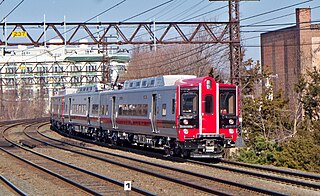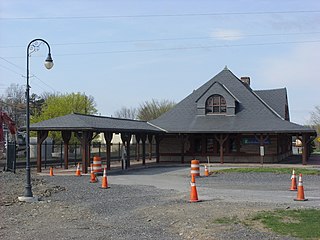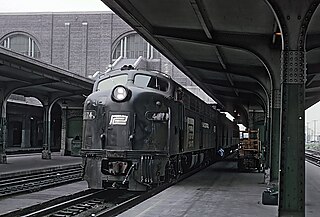Related Research Articles

The New York, New Haven and Hartford Railroad, commonly known as The Consolidated, or simply as the New Haven, was a railroad that operated principally in the New England region of the United States from 1872 to 1968. Founded by the merger of the New York and New Haven and Hartford and New Haven railroads, the company had near-total dominance of railroad traffic in Southern New England for the first half of the 20th century.

The Delaware, Lackawanna and Western Railroad, also known as the DL&W or Lackawanna Railroad, was a U.S. Class 1 railroad that connected Buffalo, New York, and Hoboken, New Jersey, and by ferry with New York City, a distance of 395 miles (636 km). The railroad was incorporated in Pennsylvania in 1853, and created primarily to provide a means of transport of anthracite coal from the Coal Region in Northeast Pennsylvania to large coal markets in New York City. The railroad gradually expanded both east and west, and eventually linked Buffalo with New York City.

The Erie Lackawanna Railway, known as the Erie Lackawanna Railroad until 1968, was formed from the 1960 merger of the Erie Railroad and the Delaware, Lackawanna & Western Railroad. The official motto of the line was "The Friendly Service Route".

The Michigan Central Railroad was originally chartered in 1832 to establish rail service between Detroit, Michigan, and St. Joseph, Michigan. The railroad later operated in the states of Michigan, Indiana, and Illinois in the United States and the province of Ontario in Canada. After about 1867 the railroad was controlled by the New York Central Railroad, which later became part of Penn Central and then Conrail. After the 1998 Conrail breakup, Norfolk Southern Railway now owns much of the former Michigan Central trackage.

Stamford station, officially known as the Stewart B. McKinney Transportation Center or the Stamford Transportation Center, is a major railroad station in the city of Stamford, Connecticut, serving passengers traveling on Metro-North Railroad's New Haven Line, and Amtrak's Northeast Corridor. In addition, it is also a major bus terminal for Greyhound, Peter Pan, and CTtransit buses. In 2018, the station averaged over 15,000 Metro-North boardings on weekdays, making it the busiest station on the system aside from Grand Central Terminal. Its official name honors politician Stewart McKinney.

The New Haven Line is a 72.7 mi (117.0 km) commuter rail line operated by the Metro-North Railroad in the U.S. states of New York and Connecticut. Running from New Haven, Connecticut, to New York City, the New Haven Line joins the Harlem Line in Mount Vernon, New York, and continues south to Grand Central Terminal in Manhattan. The New Haven Line carries 125,000 passengers every weekday and 39 million passengers a year. The busiest intermediate station is Stamford, with 8.4 million passengers, or 21% of the line's ridership.
The Ulster and Delaware Railroad (U&D) was a railroad located in the state of New York. It was often advertised as "The Only All-Rail Route to the Catskill Mountains." At its greatest extent, the U&D extended 107 miles (172 km) from Kingston Point on the Hudson River through the Catskill Mountains to its western terminus at Oneonta, passing through the counties of Ulster, Delaware, Schoharie and Otsego.

The New Canaan Branch is an 8.2-mile (13 km) long branch line of the Metro-North Railroad New Haven Line that begins from a junction east of downtown Stamford, Connecticut, north to New Canaan. It opened in 1868 as the New Canaan Railroad.

The Danbury Branch is a diesel branch of the Metro-North Railroad's New Haven Line in the U.S. state of Connecticut, running from downtown Norwalk north to Danbury. It opened in 1852 as the Danbury and Norwalk Railroad. Until the early 1970s, passenger service continued north from Danbury to Canaan, Connecticut, and Pittsfield, Massachusetts. Metro-North took over operation of the line from Conrail in 1983, and the modern-day branch is mostly single-tracked.

The Cape Codder was a seasonal passenger train operated by Amtrak between New York City and Hyannis, Massachusetts, on Cape Cod. It operated during the summer between 1986 and 1996. It was the first regular service from New York to the Cape since 1964. The New York, New Haven and Hartford Railroad previously had operated a train under this name until 1958.

Rhinecliff station is an Amtrak intercity rail station located in the Rhinecliff hamlet of Rhinebeck, New York, United States. The station has one low-level island platform, with a wheelchair lift for accessibility. It is served by the Adirondack, Berkshire Flyer, Empire Service, Ethan Allen Express, Lake Shore Limited, and Maple Leaf.
Grand Hotel station, MP 41.4 of the Ulster and Delaware Railroad, was located in the small mountain hamlet of Highmount, New York, at the summit between Big Indian and Arkville. A turntable was located here, allowing pusher engines to be turned before descending to Arkville or Big Indian.

The station at Fleischmanns, New York, MP 44.1 of the Ulster and Delaware Railroad, was originally called Griffin's Corners station, as that was the town's original name. It was situated on a hill high above the busy town, and, like the town, was always very busy itself. Changes were made to the station when the New York Central purchased the line in 1932; a room was added on, and a chimney and a lookout room on the second floor were removed. The New York Central continued passenger service into the early 1950s, discontinuing it by early 1954. It survived even afterwards, but all that remains now is a freight house, which is used by the Delaware and Ulster Railroad.
Hobart was a former railroad station in the village of Hobart, Delaware County, New York, United States. The station was run by the New York Central Railroad as part of their Catskill Mountain Branch and located 77.5 miles (124.7 km) from the eastern terminus at Kingston Point station in the city of Kingston. Railroad service in Hobart began on December 1, 1884, when the Hobart Branch Railroad opened for service from nearby Stamford station, an extension of 3.61 miles (5.81 km). The station closed when the railroad discontinued service on the branch on March 31, 1954.

The Ocala Union Station is a bus station and former train station in Ocala, Florida, United States. It is located at 531 Northeast First Avenue, and was built in 1917 by both the Atlantic Coast Line and Seaboard Air Line Railroad. Prior to this, ACL and SAL had separate depots in Ocala. The former ACL station was originally built by the Florida Southern Railroad, while the former SAL station was built by the Florida Transit and Peninsular Railroad. On December 22, 1997, it was added to the U.S. National Register of Historic Places.

Union Station served the residents of Chatham, New York, from 1887 to 1972 as a passenger station and until 1976 as a freight station. It was the final stop for Harlem Line trains. It had originally served trains of the Boston and Albany Railroad, then the New York Central Railroad and the Rutland Railway. It served as a junction for service that radiated to Rensselaer, New York, to the northwest; Hudson, New York, to the southwest; Vermont, to the northeast, and Pittsfield, Massachusetts to the east and New York City, to the south.

The Graham Line is the portion of the former Erie Railroad in New York State from Highland Mills to Guymard, constructed from 1906 to 1909 as a high-speed freight line. The Graham Line bypasses the original Erie Main Line through Monroe, Chester, Goshen and Middletown.

The Southwestern Limited was a passenger train service operated by the New York Central Railroad between New York City and St. Louis, from 1889 to 1966. The Southwestern Limited was one of the New York Central's luxury passenger trains. This passenger train competed with the other major railroad in the northeast, the Pennsylvania Railroad, and its Blue Ribbon named passenger trains the St. Louisan, the Jeffersonian, the Penn Texas and the Spirit of St. Louis.

The Buffalo Day Express was a long-distance north–south Pennsylvania Railroad passenger train from Washington, D.C., to Buffalo, New York. It had a second branch that originated in Philadelphia, Pennsylvania, and at times, from New York, New York. In the southbound direction, the train ran by the name, Washington Express. It was the longest running of trains on the Washington-Buffalo route, north through central Pennsylvania on the Buffalo Line, operating from 1900 to the latter years of the 1960s, with a shortened segment until 1971.

Canton station, or Canton–Akron station, is a former train station in Canton, Ohio.
References
- ↑ "Final Old U.&D. Passenger Train Trip Wednesday". The Kingston Daily Freeman. March 30, 1954. pp. 1, 8 . Retrieved May 6, 2021– via Newspapers.com.

- ↑ New York Central Timetable, December 1953, Table 50
- ↑ New York Central Timetable, April 1954, dropped from timetable